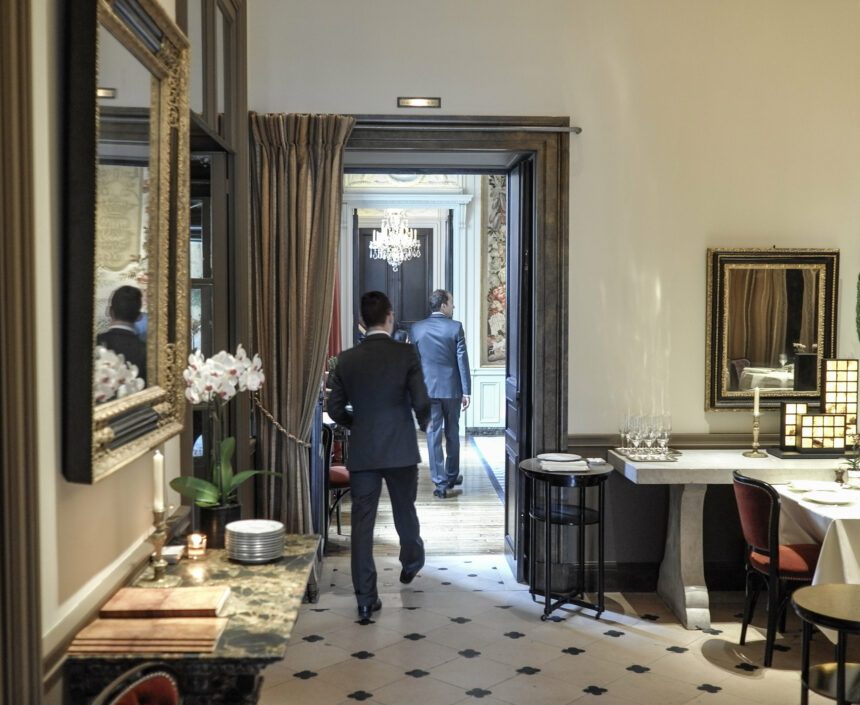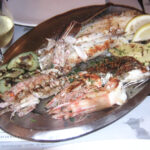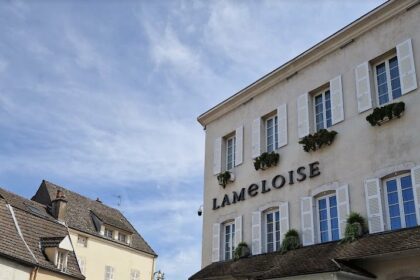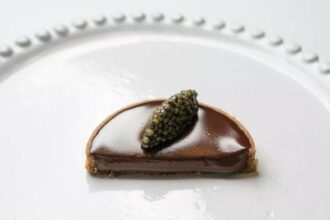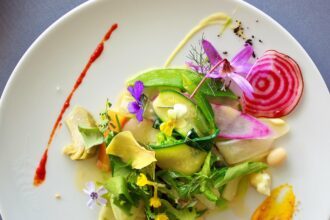Following some stunning meals in the Spanish Basque country and in Northern Italy, we stayed in Paris to dine at L’Ambroisie and Le Cinq. Recently there has been some speculation about the demise of top end cuisine in France (for the lack of a better word, let’s call it Haute Cuisine or HC). Moreover, the remarks attributed to Berasatequi by a perceptive reviewer of the Spanish scene is hardly an unorthodox statement anymore (Berasetequi, when asked whether or not he considered the backbone of his cuisine to be French quipped: “No. Besides, we all know that French cuisine is on the verge of its death!”). This is because the French themselves are nowadays undergoing some soul searching and are no more oblivious to gastronomical developments elsewhere.
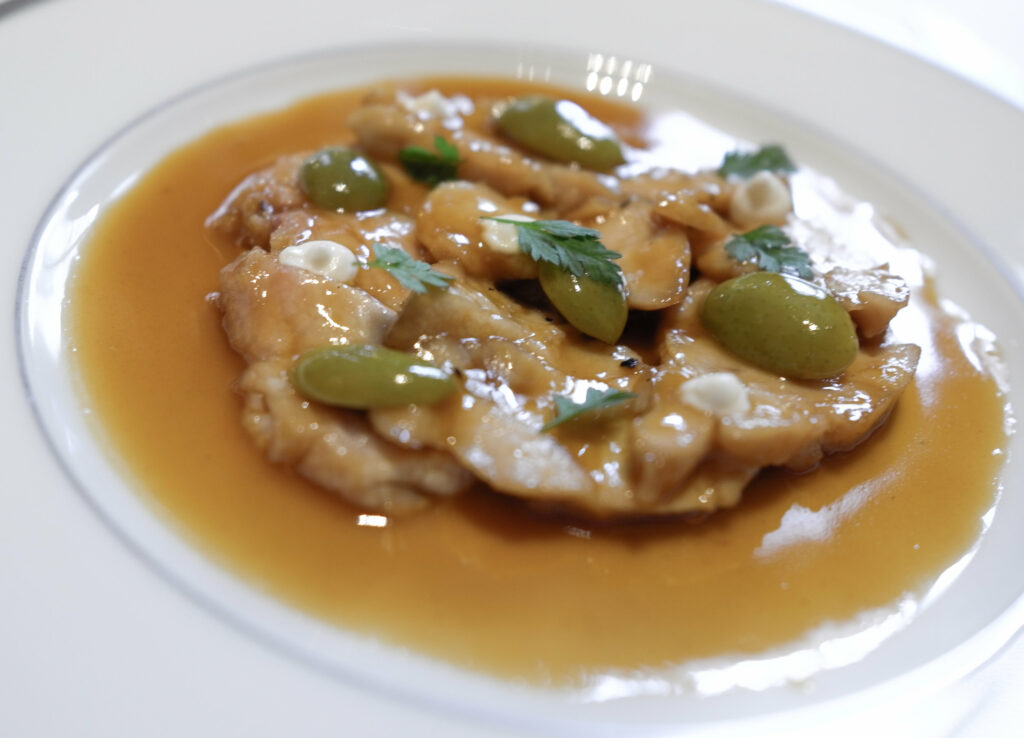
But, sensationalism and marketing gimmicks aside, is it true that the HC in France is on the verge of death? My answer to that question may sound equivocal at first: Yes, and No. Yes, it is dying when the French cater to the level and expectations of an international clientele and start cutting corners in classical dishes, or, supposedly move in a “fusion” and creative direction by, say, imitating techniques and using ingredients from Asian cuisine in a superficial way without dedicating themselves to develop the required new skills and holistic understanding of these foreign cuisines. It is also dying when top French chefs, partly to justify hefty bills and partly to respond to demands for “luxurious” ingredients on the part of unsuspecting and inexperienced clientele, start to utilize out of season, frozen or second rate ingredients. Worse still, the cuisine suffers when, in an effort to please everybody, top French chefs sail against the winds and compose very large menus with 15 appetizers, 20 fish, 30 meat dishes and so on. What we end up with is a technically proficient but soulless cuisine where more than an optimum component of a complex dish is precooked. I call this an assembly line three star meal. But please do not mistake one thing. I believe some current 3 stars in Paris who are guilty of caving in to market pressures are extremely capable and great chefs. If they choose to or if you are important to them, they can concoct extremely satisfying and grandiose dishes. Hence, having an unsatisfactory meal, say at Lucas Carton, means nothing about Senderens’ ability and capacity. At gun point I would say that Senderens is a greater chef than the 30 years of Massimiliano Alajmo at Le Calandre (which may change though as the latter extremely talented Italian matures) in the sense that he has created more dishes which have become classics. But you are much more likely to dine better and cheaper today in Le Calandre than in many of the Parisian 3 stars because Massimiliano will give any unknown diner 90% of what he is capable of, whereas you will be lucky if Legendre or Senderens are even in the kitchen when you dine there.
On the other hand and fortunately, there is the other side of the coin and old habits die hard. There are those great artisans in France, who are unwilling to give any concession from the search for perfectionism. Perfectionism for them means, above all, a constant search to seek the most pure flavors of natural products. They know that a great dish can be made of simple, inexpensive produce if it is of exceptional quality. But the converse is not true. That is to say, a truly great dish can not be made of second rate products even if we are talking about luxurious products, such as white truffles, black truffles, caviar, lobster and what not. Perfectionism for these chefs also means staying in the kitchen and trying to patiently perfect the dishes before they are included in a menu. These chefs are not carried away by the temptation to create new and newer dishes all the time and to impress the inexperienced diner with a series of small tapas which follow one another in dizzying speed. Their menus, even in the 3-stars, are generally shorter and change often according to season. But, at the most exalted levels and when we are talking about the greatest of the great chefs, such as the old Robuchon at Jamin and Girardet (although not French) and Pacaud and Passard, these chefs are not conservative. They stay abreast of new culinary developments, such as in molecular gastronomy, and they are not threatened by, say, what a culinary “enfant terrible” is concocting in Catalunia or the Basque country. If new and previously undiscovered combinations are suggested by looking at the molecules present in various ingredients, these chefs are willing to experiment. But they experiment carefully. Indeed I will go out on a limb and suggest a tentative conclusion that being an avant garde chef does not necessarily mean that one is a non-conformist. Innovation for innovation’s sake to the detriment of natural flavors is also a conformist attitude when it achieves the status of a cult following, and we see plenty examples of that not only in Spain and the US, but also in France… Somehow not in Italy though.
Let me now illustrate what I am saying with reference to 2 meals I have recently had in France: December 3, Friday, at L’Ambroisie, and the next day at Le Cinq. Of course the positive and negative models I developed above are what the great social scientist Max Weber would call “ideal types” in the sense that they are just a heuristic approximation to make comparison possible. I can also attest that Legendre is a great cuisinier and if he chose to, he can prepare epicurean meals. The dining staff team in the hotel George Cinq is not just, merely good. They are absolutely perfect. They give no concession whatsoever from the grand tradition of French hospitality cum professionalism and the way they organize and orchestrate different aspects of the meal service reaches a level that only happens in France (assuming Monaco is in France), if you know what I mean.
And the food is just good enough not to lose its exalted 3-stars rating. But there is an assembly line, precooked quality to most dishes. Even the famous lobster dish with a heavenly combination of chestnuts and cepes is probably precooked and then finished quickly in a smoker to emulate the incomparable taste of a la plancha or grill or parrilla cooking I just reviewed. Hence the chopped off lobster tail itself by no means compares to the heavenly taste I had at Etxebarri which I reviewed and posted the pictures. But the dish itself, with a frothy nantua like sauce and the contrast/complementarity endowed by two great ingredients which are both seasonal, i.e. the cepes (porcini) and chestnuts is a triumph of conception. This is the best one can do to serve the dish in one portion and as part of the tasting menu. (It was part of the tasting menu but we ordered it from the a la carte menu.) But what is best under these circumstances is not good enough to deliver the sublime level this dish is potentially capable of achieving. As such, and if you want to eat “sophisticated” preparations of lobster, head to Arpege for his whole lobster in vin jaune and turnips preparation, or to l’Ambroisie for his matelote with red wine and new potatoes when new potatoes are in season in Spring, or to Cancale to eat at Roellinger. Or else, pay less and have a la plancha lobster in seafood brasseries anywhere in Brittany!
I gave the example of the lobster dish because it was still very good and showed some tensions between the concerns of a luxurious hotel and the demands of international clientele on the one hand, and the requisites of perfectionist French HC on the other. Other dishes were less good at Le Cinq and the desserts were just above average. Even the tourte de gibier, wild game torte that was a Legendre classic at Taillevent was no better than you would get at the best bistros in Paris, and it was clearly precooked and reheated. The restaurant also serves black truffles frozen (and they are imperceptible in the dishes that cite them). We were dissuaded from ordering a dish with white truffles because the quality was not very good (acknowledging this shows the integrity and honesty of the captain, so I am actually happy about being told this).
But then, given the Michelin’s unfortunate overemphasis on technique at the expense of ingredients and also given the expectations of the clientele which sure will be impressed by the superb setting and service, is there any reason to try harder? I cannot think of any. To put it in the parlance of new theologians that I interact with: “what are the incentives to upgrade?”
Well, frankly I cannot think of any monetary incentives given that all 3 stars in Paris are doing well even though some operate below the level of the best 2 stars (like Meurice and Le Bristol). But there is something else. There is an inner drive for perfectionism and perhaps reputational concerns which still enable some French chefs to create a cuisine at a level that, how to put it, is at a level which makes the discriminating diners feel blessed and ensures that they comprehend that cuisine can have a transcendental dimension.
From the mid-80s to mid-90s I had this feeling of transcendentalism at Robuchon more than in any other restaurant. And, in the last 10 years, it is L’Ambroisie which ascended in the ranks and more often than not makes me ecstatic.
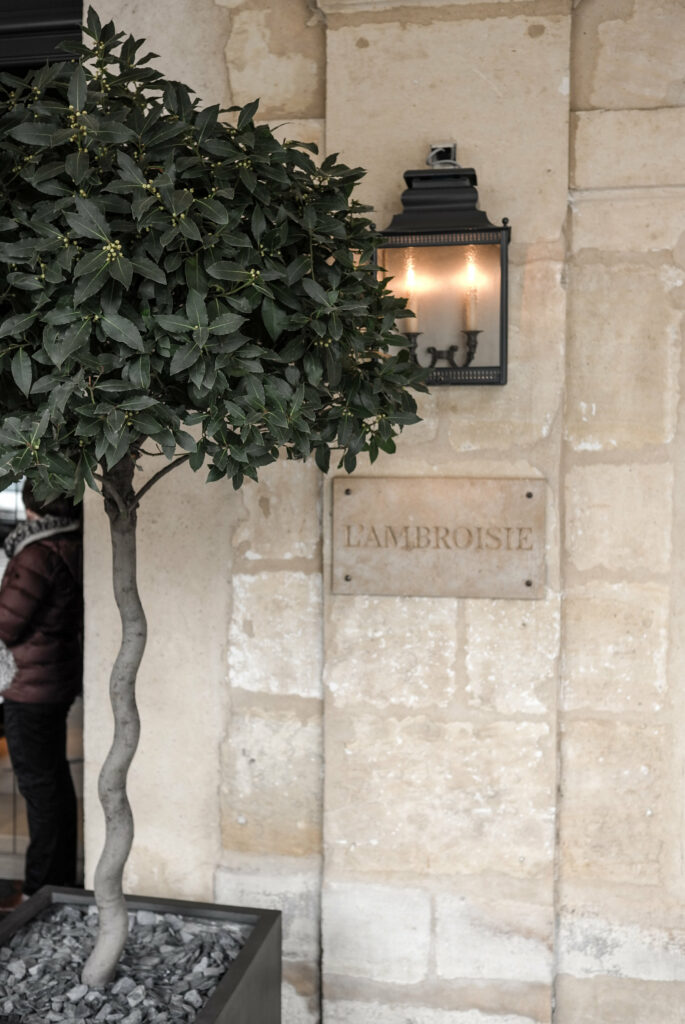
I do not want to dwell on the details and make a painstaking analysis of each dish, but let me say a few things. First, L’Ambroisie, contrary to general opinion, is not a temple-like place. Under Monsieur Caimant, the old Jamin was such a place, but not L’Ambroisie. The setting in the ancient Place des Vosges is very refined and apt. The service and the general philosophy of the restaurant though, under the direction of Monsieur LeMoullac, who is also a true connoisseur of great wine, is actually very professional and full of humor and joy of life at the same time. Second, the chef Monsieur Pacaud is almost always there (he may greet you when you come), yet do not expect him to make rounds with a smirk on this face as this is a shy man who expresses himself with his work. Third, do not expect to find all luxurious ingredients all the time there. Pacaud menus typically consist of 5 appetizers, 3 to 4 seafood courses and a maximum of 5 meats. They also change seasonally. What does not change is that Pacaud always sources the best products, and he will not offer, say, black truffles, even in mid-January, if they are not ripe enough for his taste. Fourth, do not expect 10+ course tasting menus at L’Ambroisie. If you make your preferences or your dislikes known, Monsieur Pascal, the Maitre d’, will put together a menu for two which will emphasize balance and harmony, the very qualities French HC amply display when it is that good.
Here is what our last menu for the two of us composed of: “soupe cremeuse d’ecrevisses au celery, chutney de poivron et ananas” or crawfish soup with celery and a chutney of pineapple and sweet red pepper, followed by “corolle de noix de St. Jacques, a la truffe blanche, mousseline de broccolis”, or scallops with a broccolis mousseline and white truffles, and, finally, “tourte de Canard Colvert au foie Gras“, wild duck torte with duck liver. Then a cheese course, then a fruit-rhum baba combination and finally the world’s best “tarte fine sablee au chocolat” to finish. And to accompany the dishes, first we had a bottle of Pernand Vergelesse from Chandon de Brialles and then a bottle of Cmambolle Musigny Les Fuees from J.F. Mugnier. Both were vintage 2000.
What makes L’Ambroisie in general and this menu in particular exciting is that each dish contains only 3 to 4 elements which all shine and complement one another, but they are there not to subtract from the main focus, but to enhance the main ingredient. Each dish is harmonious in itself, but in progressive succession they create a crescendo effect. All of the dishes respect the ingredients of which they are made, but when all are combined together they are calibrated in such a way that the overall effect is greater than the sum of the ingredients. And on top of it, this is by no means heavy, butter laden cooking. It is classical cuisine but calibrated to modern taste, but with no short cuts.
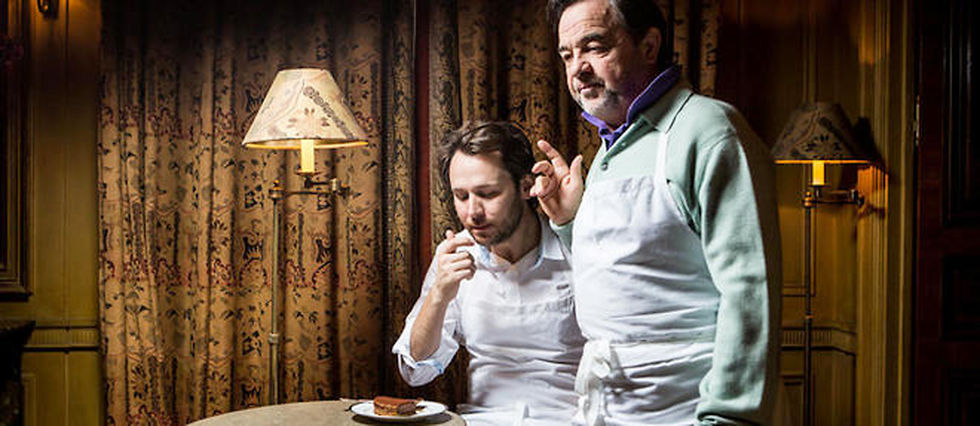
Take the scallop dish. I wish I had a picture of this dish to look at like I admire good paintings. Brocolis are young and tender and emerald green, and the olive oil based sauce is so limpid and green that the white scallops in the middle and the very white and large truffle pieces on top (sliced from half pound aromatic truffles) look like some large and flawless diamond has been planted in the middle of a ring consisting of small, leaf shaped emeralds on the outer ring. And the dish tastes as good as it looks. It is the clarity and the intensity of the tastes that strike you, and there is nothing you can do to this dish to improve it further.
Take the wild game tourte or game pot pie. Different parts of duck (leg and breast) are done to perfection, which is pretty amazing since they all require different cooking times, and they are all in the same pie. There are 3 colors ranging from very pink (the duck liver) to light brown and dark brown (the leg I guess). You can taste each of them separately, they are thick; the pie is made to order and cooked to order as all the 6 slices are going around to appreciative diners. The crust is clearly homemade and very tasty in itself. The sauce is very intense but it is the natural intensity of game, enriched with an ample quantity of wild mushrooms (cepes) and mushroom stock, not mounds of butter. This is a type of dish where it is better not to prepare it because it will amount to overreaching in the hands of lesser chefs. It is also a dish that nobody dares to prepare without shortcuts in the 21st century. It is also a dish that you will appreciate more if you like real game and you sequence your menu carefully. When all these factors converge, and when cooking is so good, you start realizing that the grand old Haute Cuisine only reaches this level in France, and this will probably continue to be the case in the foreseeable future.
